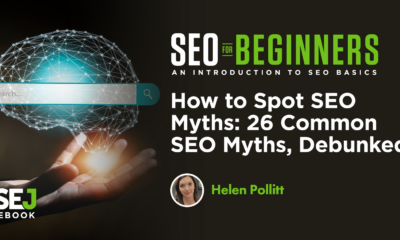MARKETING
Stop Writer’s Block, Imposter Syndrome, and Other Content Fears

When writing for content marketing, the process becomes even more challenging. You have no time to sit and wait for inspiration or the muse to help you craft engaging text. You have content plans to follow and deadlines to meet.
That’s when fear arises.
Raise your hand if one of these whispers creeps into your mind when you try to write:
- “A better article exists already. My content is a pathetic copy.”
- “I’m not good enough. I can’t write better than [your guru’s name here].”
- “So much info! Can I structure all of it? I’ll miss something essential.”
- “What should I write?”
- “They won’t like it. I’ll get rejected.”
- “My draft sucks; it’s boring.”
- “Johnny writes 1,000 words every day. I’m too slow.”
Writing fears fall into two categories: doubts about your abilities or concern over others’ judgment of your work. You can tame blank-page syndrome, imposter syndrome, writer’s block, or whatever stops you from creating great content with these seven simple yet effective tricks.
Writing fears fall into two categories – doubts about your abilities and concern over others’ judgment of your work, says @LesleyVos via @CMIContent. #ContentMarketing Click To Tweet
1. Practice therapeutic writing
Therapeutic writing will help prevent blank-page syndrome – staring at the screen with no idea how to start a content piece. Some blame this on a lack of inspiration, while others use grimmer diagnoses like emotional burnout or even workplace depression. Skeptics are less euphemistic, calling it nothing but the fear of writing crap.
To beat it, develop a daily writing habit. You may have heard about Morning Pages – a system that has you write (in long hand) three pages of stream-of-consciousness text first thing in the morning. Following free-writing practices and keeping a diary also fall into this category. If these exercises work for you, great. If not, you can try therapeutic writing.
Keep a journal where you regularly write a letter to a chosen addressee, telling them about daily events that made you angry, sad, anxious, or happy. You may publish these as short sketches on social media.
In the post below, the author at handle @heyamberrae pens a letter to her followers about “experiencing the most extraordinary love” she’s ever known.
How can therapeutic writing help with professional content writing?
Practicing such reflective writing makes you less likely to freeze at that intimidating text cursor. You’ll beat the fear of an imperfect draft and use the “write-first, edit-later” rule we all know (but often forget).
2. Start a ‘clever-thoughts’ notebook
A notebook with clever thoughts is not a collection of quotes from writing gurus and influences, though that could be an inspiring practice.
A clever-thoughts notebook contains the ideas, sentences, and interesting facts you learn during the day from books, websites, etc. An average person has around 6,000 thoughts daily but forgets most by evening, so the notebook will help you remember your best ones. And that list will come in handy next time you need to write text but worry you have nothing to say.
Jot down your clever thoughts in a notebook. They may come in handy the next time you struggle to come up with content ideas says @LesleyVos via @CMIContent. Click To Tweet
3. Record your voice
Сreative content ideas, topics, and arguments may come to you when you’re nowhere near your laptop or a notebook. Haven’t we all had a brilliant idea caught in the dead of night, only to forget everything by morning?
Other times your thoughts flow freely – until you try to write them down. When you sit down to summon the right words, you forget what you wanted to say.
It’s like this meme, which I tweaked for content writing: You envisioned a real-life dog, but your writing only produces the socket puppet version.
To avoid writer’s block and still get your idea down, record your thoughts when they come to you. Then transcribe the recording or use the voice-typing feature in your writing app. You’ll be able to structure your dictated thoughts into content assets later.
4. Opine on opinions
This trick can help you beat the you’re-not-good-enough writing fear.
After reading an influencer’s thoughts and insights on a topic, think of supporting arguments or counterarguments. Then, write them down as if you were having a dialogue with that person.
The tactic helps you think critically, develop arguments, structure the facts, and manage your information priorities. It serves you in crafting more comprehensive content, whether you write about restaurants, create cause-related posts, or practice guest blogging to reach content marketing goals.
Writing trick: Read a respected person’s thoughts on a topic and write a counterargument, says @LesleyVos via @CMIContent. #ContentMarketing Click To Tweet
5. Mirror your favorite writer
It stands to reason that content creators read a lot. As my favorite author, Stephen King, says, “If you don’t have time to read, you don’t have the time (or the tools) to write. Simple as that.”
And, as my second yet no less favorite writer Ernest Hemingway said, “There’s no friend as loyal as a book.” Not only can these loyal friends make your content better, but they can help smash the fear of rejection and not being good enough to write.
(Confession: I had both those fears before pitching my first article to the Content Marketing Institute.)
Who is your favorite writer, essayist, or blogger? Do you analyze their writing style while reading? Do you notice language tricks they use?
Mirroring a writer is among the most efficient techniques for developing a writing style. It helps enhance your vocabulary, add a few alternative writing tactics to your content creation toolkit, and conquer your fear of criticism.
(Confession: Once I learned that Stephen King got 30 rejections before his book Carrie was published, there was no room left for the “not good enough” fear.)
6. Read the news and niche resources
The daily habit of reading the news and niche blogs brings benefits for content writers. These include:
- Better cognitive skills and brain functioning
- Enriched vocabulary
- New ideas for content creation
- Writing style inspiration
But please note: This trick won’t work if you read everyone and everything. Make a list of professional resources that inspire and educate you at the same time.
(Confession: I learned the art of web writing from Ann Handley and Jon Morrow. And Henneke Duistermaat’s works help me feel the beauty of English and make peace with my inner critic. Plus, her list of writing fears inspired me to create this article.)
This tweet from Henneke describes how she used to think of herself as a writing wimp and pondered why she couldn’t be as confident as others. But she discovered that writing fears are normal – the fear signals that you’re out of your comfort zone and writing something that matters.
I used to think I was a writing wimp.
Why couldn’t I be as confident as everyone else?
But I’ve discovered: Writing fears are normal.
Fears are sign you’re out of your comfort zone & you’re writing something that matters.
So, dance with your fears >>> https://t.co/PLoSQw2bei pic.twitter.com/Y4jpu72Wld
— Henneke Duistermaat (@HennekeD) November 3, 2022
Who is on your list of resources to follow?
7. Stay in a professional space
A great practice to smash fears and self-doubts for content writers is to stay in the professional space. Attend seminars, participate in conferences or webinars, visit local meetings, communicate with interesting people on social media, etc. These interactions can prevent you from hitting a plateau and enhance writing productivity.
Social participation can trigger happy chemicals in the brain to satisfy the need for excitement. This excitement acts as an inspiration to write more and “forget” the imposter syndrome and other writing fears for a while.
Ready to say goodbye to your writing fears?
Fears (of a blank page, failure, rejection, writing crap, or not being good enough) act like little beasts, gnawing at your writing ego and preventing you from enjoying the content creation process.
Once you name your beast, you can arm yourself with one or more of these tricks to help you smash them.
HANDPICKED RELATED CONTENT:
Cover image by Joseph Kalinowski/Content Marketing Institute
MARKETING
YouTube Ad Specs, Sizes, and Examples [2024 Update]
![YouTube Ad Specs, Sizes, and Examples [2024 Update] YouTube Ad Specs, Sizes, and Examples](https://articles.entireweb.com/wp-content/uploads/2024/06/YouTube-Ad-Specs-Sizes-and-Examples.jpg)
Introduction
With billions of users each month, YouTube is the world’s second largest search engine and top website for video content. This makes it a great place for advertising. To succeed, advertisers need to follow the correct YouTube ad specifications. These rules help your ad reach more viewers, increasing the chance of gaining new customers and boosting brand awareness.
Types of YouTube Ads
Video Ads
- Description: These play before, during, or after a YouTube video on computers or mobile devices.
- Types:
- In-stream ads: Can be skippable or non-skippable.
- Bumper ads: Non-skippable, short ads that play before, during, or after a video.
Display Ads
- Description: These appear in different spots on YouTube and usually use text or static images.
- Note: YouTube does not support display image ads directly on its app, but these can be targeted to YouTube.com through Google Display Network (GDN).
Companion Banners
- Description: Appears to the right of the YouTube player on desktop.
- Requirement: Must be purchased alongside In-stream ads, Bumper ads, or In-feed ads.
In-feed Ads
- Description: Resemble videos with images, headlines, and text. They link to a public or unlisted YouTube video.
Outstream Ads
- Description: Mobile-only video ads that play outside of YouTube, on websites and apps within the Google video partner network.
Masthead Ads
- Description: Premium, high-visibility banner ads displayed at the top of the YouTube homepage for both desktop and mobile users.
YouTube Ad Specs by Type
Skippable In-stream Video Ads
- Placement: Before, during, or after a YouTube video.
- Resolution:
- Horizontal: 1920 x 1080px
- Vertical: 1080 x 1920px
- Square: 1080 x 1080px
- Aspect Ratio:
- Horizontal: 16:9
- Vertical: 9:16
- Square: 1:1
- Length:
- Awareness: 15-20 seconds
- Consideration: 2-3 minutes
- Action: 15-20 seconds
Non-skippable In-stream Video Ads
- Description: Must be watched completely before the main video.
- Length: 15 seconds (or 20 seconds in certain markets).
- Resolution:
- Horizontal: 1920 x 1080px
- Vertical: 1080 x 1920px
- Square: 1080 x 1080px
- Aspect Ratio:
- Horizontal: 16:9
- Vertical: 9:16
- Square: 1:1
Bumper Ads
- Length: Maximum 6 seconds.
- File Format: MP4, Quicktime, AVI, ASF, Windows Media, or MPEG.
- Resolution:
- Horizontal: 640 x 360px
- Vertical: 480 x 360px
In-feed Ads
- Description: Show alongside YouTube content, like search results or the Home feed.
- Resolution:
- Horizontal: 1920 x 1080px
- Vertical: 1080 x 1920px
- Square: 1080 x 1080px
- Aspect Ratio:
- Horizontal: 16:9
- Square: 1:1
- Length:
- Awareness: 15-20 seconds
- Consideration: 2-3 minutes
- Headline/Description:
- Headline: Up to 2 lines, 40 characters per line
- Description: Up to 2 lines, 35 characters per line
Display Ads
- Description: Static images or animated media that appear on YouTube next to video suggestions, in search results, or on the homepage.
- Image Size: 300×60 pixels.
- File Type: GIF, JPG, PNG.
- File Size: Max 150KB.
- Max Animation Length: 30 seconds.
Outstream Ads
- Description: Mobile-only video ads that appear on websites and apps within the Google video partner network, not on YouTube itself.
- Logo Specs:
- Square: 1:1 (200 x 200px).
- File Type: JPG, GIF, PNG.
- Max Size: 200KB.
Masthead Ads
- Description: High-visibility ads at the top of the YouTube homepage.
- Resolution: 1920 x 1080 or higher.
- File Type: JPG or PNG (without transparency).
Conclusion
YouTube offers a variety of ad formats to reach audiences effectively in 2024. Whether you want to build brand awareness, drive conversions, or target specific demographics, YouTube provides a dynamic platform for your advertising needs. Always follow Google’s advertising policies and the technical ad specs to ensure your ads perform their best. Ready to start using YouTube ads? Contact us today to get started!
MARKETING
Why We Are Always ‘Clicking to Buy’, According to Psychologists

Amazon pillows.
MARKETING
A deeper dive into data, personalization and Copilots

Salesforce launched a collection of new, generative AI-related products at Connections in Chicago this week. They included new Einstein Copilots for marketers and merchants and Einstein Personalization.
To better understand, not only the potential impact of the new products, but the evolving Salesforce architecture, we sat down with Bobby Jania, CMO, Marketing Cloud.
Dig deeper: Salesforce piles on the Einstein Copilots
Salesforce’s evolving architecture
It’s hard to deny that Salesforce likes coming up with new names for platforms and products (what happened to Customer 360?) and this can sometimes make the observer wonder if something is brand new, or old but with a brand new name. In particular, what exactly is Einstein 1 and how is it related to Salesforce Data Cloud?
“Data Cloud is built on the Einstein 1 platform,” Jania explained. “The Einstein 1 platform is our entire Salesforce platform and that includes products like Sales Cloud, Service Cloud — that it includes the original idea of Salesforce not just being in the cloud, but being multi-tenancy.”
Data Cloud — not an acquisition, of course — was built natively on that platform. It was the first product built on Hyperforce, Salesforce’s new cloud infrastructure architecture. “Since Data Cloud was on what we now call the Einstein 1 platform from Day One, it has always natively connected to, and been able to read anything in Sales Cloud, Service Cloud [and so on]. On top of that, we can now bring in, not only structured but unstructured data.”
That’s a significant progression from the position, several years ago, when Salesforce had stitched together a platform around various acquisitions (ExactTarget, for example) that didn’t necessarily talk to each other.
“At times, what we would do is have a kind of behind-the-scenes flow where data from one product could be moved into another product,” said Jania, “but in many of those cases the data would then be in both, whereas now the data is in Data Cloud. Tableau will run natively off Data Cloud; Commerce Cloud, Service Cloud, Marketing Cloud — they’re all going to the same operational customer profile.” They’re not copying the data from Data Cloud, Jania confirmed.
Another thing to know is tit’s possible for Salesforce customers to import their own datasets into Data Cloud. “We wanted to create a federated data model,” said Jania. “If you’re using Snowflake, for example, we more or less virtually sit on your data lake. The value we add is that we will look at all your data and help you form these operational customer profiles.”
Let’s learn more about Einstein Copilot
“Copilot means that I have an assistant with me in the tool where I need to be working that contextually knows what I am trying to do and helps me at every step of the process,” Jania said.
For marketers, this might begin with a campaign brief developed with Copilot’s assistance, the identification of an audience based on the brief, and then the development of email or other content. “What’s really cool is the idea of Einstein Studio where our customers will create actions [for Copilot] that we hadn’t even thought about.”
Here’s a key insight (back to nomenclature). We reported on Copilot for markets, Copilot for merchants, Copilot for shoppers. It turns out, however, that there is just one Copilot, Einstein Copilot, and these are use cases. “There’s just one Copilot, we just add these for a little clarity; we’re going to talk about marketing use cases, about shoppers’ use cases. These are actions for the marketing use cases we built out of the box; you can build your own.”
It’s surely going to take a little time for marketers to learn to work easily with Copilot. “There’s always time for adoption,” Jania agreed. “What is directly connected with this is, this is my ninth Connections and this one has the most hands-on training that I’ve seen since 2014 — and a lot of that is getting people using Data Cloud, using these tools rather than just being given a demo.”
What’s new about Einstein Personalization
Salesforce Einstein has been around since 2016 and many of the use cases seem to have involved personalization in various forms. What’s new?
“Einstein Personalization is a real-time decision engine and it’s going to choose next-best-action, next-best-offer. What is new is that it’s a service now that runs natively on top of Data Cloud.” A lot of real-time decision engines need their own set of data that might actually be a subset of data. “Einstein Personalization is going to look holistically at a customer and recommend a next-best-action that could be natively surfaced in Service Cloud, Sales Cloud or Marketing Cloud.”
Finally, trust
One feature of the presentations at Connections was the reassurance that, although public LLMs like ChatGPT could be selected for application to customer data, none of that data would be retained by the LLMs. Is this just a matter of written agreements? No, not just that, said Jania.
“In the Einstein Trust Layer, all of the data, when it connects to an LLM, runs through our gateway. If there was a prompt that had personally identifiable information — a credit card number, an email address — at a mimum, all that is stripped out. The LLMs do not store the output; we store the output for auditing back in Salesforce. Any output that comes back through our gateway is logged in our system; it runs through a toxicity model; and only at the end do we put PII data back into the answer. There are real pieces beyond a handshake that this data is safe.”
-

 SEARCHENGINES5 days ago
SEARCHENGINES5 days agoBillions Of Google goo.gl URLs To 404 In The Future
-

 SEO7 days ago
SEO7 days ago26 Common SEO Myths, Debunked
-
SEARCHENGINES4 days ago
Daily Search Forum Recap: July 22, 2024
-

 SEARCHENGINES6 days ago
SEARCHENGINES6 days agoGoogle Core Update Coming, Ranking Volatility, Bye Search Notes, AI Overviews, Ads & More
-

 SEO5 days ago
SEO5 days ago11 Copyscape Alternatives To Check Plagiarism
-

 SEO6 days ago
SEO6 days agoGoogle Warns Of Last Chance To Export Notes Search Data
-
SEARCHENGINES3 days ago
Daily Search Forum Recap: July 23, 2024
-

 AFFILIATE MARKETING6 days ago
AFFILIATE MARKETING6 days agoThe Top 5 AI Tools That Can Revolutionize Your Workflow and Boost Productivity
















You must be logged in to post a comment Login